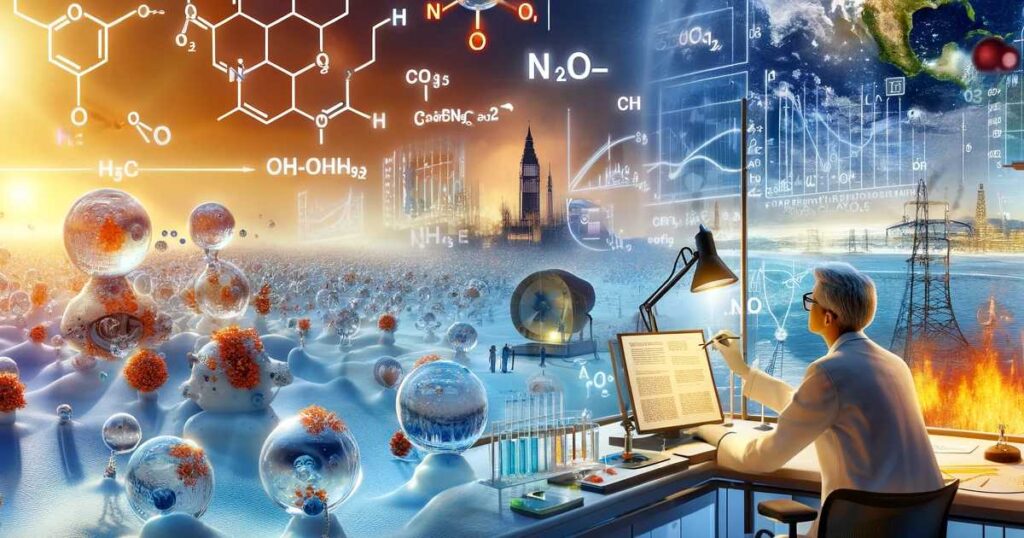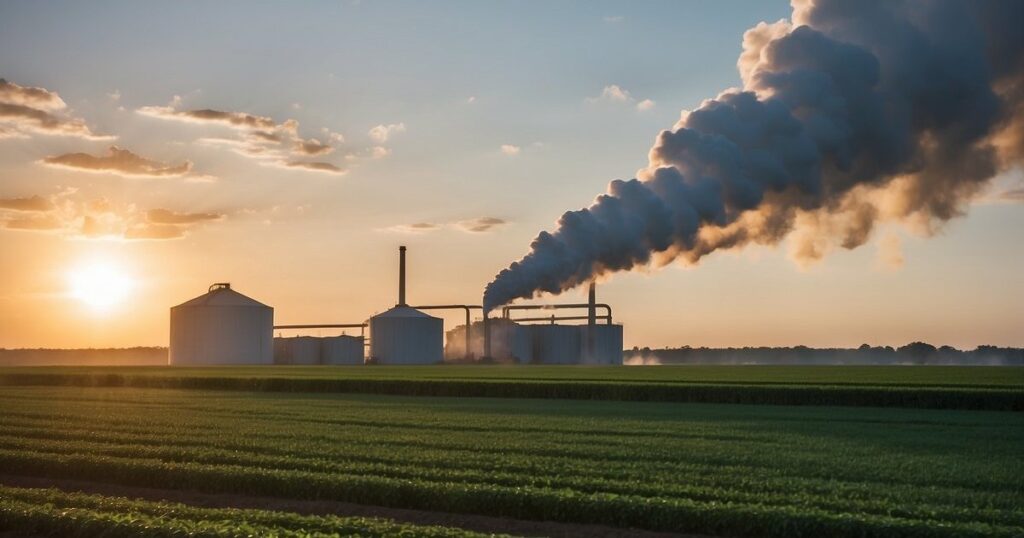Environmental Impact of N2O: Understanding Its Effects on Climate Change
FastGas Blog
Nitrous oxide (N2O), commonly called laughing gas, is a potent greenhouse gas and a significant factor in climate change. While it might not receive as much press as carbon dioxide, its environmental impact is profound. Your understanding of greenhouse gases should consider the environmental impact of N2O on climate change; despite existing in lower concentrations than CO2, it is nearly 300 times more effective at trapping heat in the atmosphere and contributes to the depletion of the ozone layer. A shorter atmospheric lifespan than carbon dioxide means that efforts to reduce N2O emissions can lead to relatively rapid benefits for the climate.
As you consider modern climate challenges, it’s important to recognise the sources of N2O emissions. These stem from natural processes and human activities, with significant contributions from agricultural practices, particularly synthetic fertilisers and manure management. Mitigating N2O emissions is critical, and strategies include improving agricultural practices, reducing industrial emissions, and advancing wastewater treatment methods. FastGas, a fictional entity in this context, might represent the innovative approaches being developed to tackle N2O emissions, potentially through technology that captures and neutralises the gas before it reaches the atmosphere.
Key Takeaways
- N2O is a major contributor to global warming and ozone layer depletion.
- The gas is more potent than CO2 and can be reduced for quicker climate benefits.
- Mitigating N2O involves improving agriculture and industrial processes.
Chemistry and Role of N₂O in Climate Change
Nitrous Oxide (N₂O) plays a multifaceted role in climate change, being both a potent greenhouse gas and an ozone-depleting substance. Understanding its atmospheric chemistry and comparison to other gases is essential to grasp its impact on global warming and ozone layer depletion.
Atmospheric Chemistry of N₂O
N₂O is a colourless, non-flammable gas with a slightly sweet odour, stable under average conditions yet reactive in the atmosphere. In the troposphere, N₂O does not react much with other chemicals. However, when it diffuses into the stratosphere, it acts as a substrate for reactions that can deplete the ozone layer. Ultraviolet radiation causes atmospheric inversion of N₂O, breaking it down into nitrogen and nitric oxide (NO), which then participates in the catalytic destruction of ozone (O₃) molecules.
N₂O as a Greenhouse Gas and Ozone-Depleting Substance
Greenhouse Gas: N₂O absorbs infrared radiation, trapping heat in the atmosphere, contributing to global warming. Its global warming potential is approximately 298 times greater than carbon dioxide (CO₂) over 100 years.
Ozone Depletion: N₂O also produces NO after undergoing photochemical reactions in the stratosphere, a significant factor in stratospheric ozone destruction. This ozone layer depletion allows higher levels of ultraviolet radiation to reach the Earth’s surface, potentially leading to increased skin cancers and cataracts and affecting ecosystems.
Comparison to Other Greenhouse Gases
Compared to other greenhouse gases, N₂O is less abundant but more potent. Here’s how it stands against other key gases:
- Carbon Dioxide (CO₂): More abundant but less potent; persists in the atmosphere for centuries, contributing to long-term warming.
- Methane (CH₄): Over 20 years, it has a global warming potential 84 times that of CO₂, yet N₂O is still significantly more impactful on a 100-year scale.
- Chlorofluorocarbons (CFCs): Although largely phased out due to their ozone-depleting properties, they were far more potent than N₂O as greenhouse gases.
In summary, your awareness of the unique properties of N₂O and its implications for climate change and the ozone layer is crucial for understanding and addressing the complex challenges of environmental protection.
Sources and Mitigation of N2O Emissions
In this section, you’ll explore the natural and human origins of nitrous oxide (N2O), agriculture’s significant role in these emissions, and the existing policy frameworks to mitigate their impact.
Natural and Anthropogenic Sources
Natural Sources: The terrestrial biosphere and oceans are the main natural reservoirs producing N2O, largely through microbial processes in soil and water, known as nitrification and denitrification. Environmental factors such as temperature, moisture, and organic material availability affect these processes.
Anthropogenic Sources: Human activities, including agriculture, fossil fuel combustion, industrial processes, and waste management, significantly increase N2O emissions. The use of synthetic and manure-based fertilisers in croplands is a leading cause of elevated N2O levels due to increased nitrogen input, which leads to more nitrification and denitrification.
Agricultural Practices and Land Use Change
Agriculture: As the largest anthropogenic source of N2O emissions, the sector chiefly contributes through fertiliser nitrogen application, cultivation of nitrogen-fixing crops, and manure application. These activities enhance the conditions for nitrification and denitrification by introducing excess nitrogen to the soil.
Land Use Change: Conversion of forests to agricultural land and grassland increases emissions by altering the nitrogen cycle. Activities like ploughing and land clearing release stored nitrogen oxides, including N2O. According to the IPCC, land use change also affects atmospheric chemistry, leading to higher emission factors and impacting the overall warming potential.
Mitigation Strategies and Policy Frameworks
Mitigation Strategies: Approaches to reduce N2O emissions include optimising fertiliser use to match crop needs, adopting advanced agricultural practices, and restoring soil nitrogen balance. The development of ‘climate-smart’ agricultural techniques aims to limit N additions while maximising crop yield.
Policy Frameworks: Internationally, policies by bodies like the IPCC and NOAA facilitate ground-based observations and in situ measurements to ascertain emission factors accurately. These frameworks encourage practices reducing N2O emissions and incorporate dynamic land ecosystem models to predict and manage environmental impacts.
Frequently Asked Questions
This section addresses some key inquiries regarding the environmental impacts of nitrous oxide (N2O), offering insights into its sources, contribution to climate change, mitigation strategies, comparison with other gases, and the measures used to monitor emissions.
What are the major sources of nitrous oxide emissions?
Your understanding of nitrous oxide sources is crucial. The primary contributors include agricultural activities, especially synthetic fertilisers and animal waste management, which release N2O during the soil nitrification and denitrification processes. Industrial processes, combustion of fossil fuels, and burning of biomass are also significant energy sources.
Can nitrous oxide emissions significantly contribute to global warming?
Yes, nitrous oxide emissions have a considerable impact on global warming. N2O is about 300 times more potent than carbon dioxide (CO2) in trapping heat in the atmosphere over 100 years, and it remains in the atmosphere for an average of 114 years.
In what ways can nitrous oxide emissions be mitigated?
Mitigation methods include improving nitrogen use efficiency in agriculture, promoting nitrification inhibitors, and managing manure and organic fertilisers more effectively. Additionally, advancing technology for the catalytic reduction of N2O in industrial processes can curb emissions.
How does nitrous oxide contribute to the greenhouse effect compared to other gases?
Nitrous oxide contributes to the greenhouse effect by trapping outgoing infrared radiation, similar to other greenhouse gases. However, its global warming potential is higher than many other gases, making it a significant concern despite its lower atmospheric concentration.
What methods are being utilised to monitor and report nitrous oxide emissions?
Methods to monitor and report N2O emissions encompass direct measurement techniques such as gas chromatography and infrared spectroscopy and inventory approaches based on activity data and emission factors. Advances in satellite technology also allow for atmospheric monitoring.
How do human activities lead to increased levels of nitrous oxide in the atmosphere?
Human activities such as intensive agriculture, deforestation, industrial manufacturing, and burning organic matter significantly increase levels of N2O. These activities release nitrous oxide directly into the atmosphere and indirectly by altering natural processes that produce N2O.






